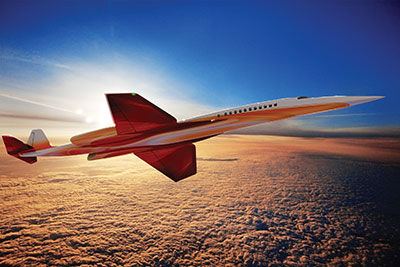
Features
Operations
Alternate Approach: Ten years after aviation slowed
More than 10 years have passed since the Concorde supersonic jet was withdrawn from revenue service and relegated to a museum piece.
January 10, 2014 By David Carr
More than 10 years have passed since the Concorde supersonic jet was withdrawn from revenue service and relegated to a museum piece. For the first time in history, air transport took a backward step – the Olympian-like motto of faster, further, higher crumbled, at least where speed was concerned.
 |
|
| The business aviation sector will be the gateway for a new generation of supersonic transport. Photo: Aerion Corporation
|
While aerospace companies like Boeing and Lockheed Martin are working to resolve the two big issues that dampened Concorde’s commercial prospects – sonic boom and the economics of supersonic flight – it is unlikely that air transport will pick up speed at a Concordian clip before 2030, at least on the airline side. What appears to be taking shape is that the business aviation sector will be the gateway for a new generation of supersonic transport.
In 2002, one year prior to the withdrawal of Concorde from commercial service, Reno, Nevada-based Aerion Corporation was formed to reintroduce commercial supersonic flight using the development of the world’s first supersonic business jet (SBJ) as its business model.
The initial pieces to build a supersonic aircraft that can transport up to 12 passengers from Toronto to London at a maximum cruise speed of Mach 1.6 in under five hours are in place. The Aerion SBJ could be powered by twin Pratt & Whitney JT8D-200 series engines, which were first introduced in the 1980s, and are in widespread use around the world. Aerion’s proprietary natural laminar flow wing is proven technology. The company has also pieced together patents for fuselage contours, inlets, engine expansion nozzles and other aerodynamic fixtures. Aerion is confident that with the right engine and airframe it can solve the sonic boom problem, with an airplane that has a “boomless” cruise speed of Mach 1.1 to 1.2, enough to fly under the ban on supersonic flights over land.
It can also expect a lot of help along the way. The National Aeronautic and Space Administration (NASA) is looking for a private partner to build a business jet size “low boom” research aircraft to gather data, while the U.S. military is developing technology that could potentially reduce aircraft take-off noise.
Integration of these various pieces, however, remains a moving target. Aerion is not the only company working on a supersonic business jet concept. But it is the only one to put that concept in the shop window at the 2013 National Business Aviation Association’s (NBAA) Convention and Exhibition in Las Vegas. Aerion updated industry watchers on the latest flight tests conducted with NASA to confirm manufacturing tolerance for a future supersonic business jet.
Even so, it is unlikely that the first development SBJ aircraft will resemble the model currently shown on the box. Tougher International Civil Aviation Organization (ICAO) noise standards, expected to be in place by 2020, have already forced a rethink in the engine. Aerion is reported to be in discussions with GE Aviation over using Passport engines modified for supersonic flight. The Passport 20 will power the Bombardier Global 7000 and 8000 aircraft. Aerion is also considering a boost to the aircraft’s range that would put Tokyo in reach of Vancouver.
In its last market survey 10 years ago, Aerion estimated that orders for a SBJ would reach 400 inside the first 15 years of production. Development of the concept was stalled by the shockwaves of the 2008 global economic meltdown, and the company is testing the market with a new survey. Aerion does not intend to develop the airplane on its own, but will be looking at a joint venture with an established business jet manufacturer. A project of this magnitude may actually call for a partnership between two airframers. Aerion anticipates a six-year development program when the project is launched.
A return to supersonic air travel appears at least technically viable, although regulators may be a hard bunch to convince when it comes to Mach plus flights overland, which is why Aerion is proposing to slow the airplane to just under Mach for the overland portion. Economics might be a tougher nut to crack. Aerion estimated the BST unit costs to be $80 million in 2007, a figure that could easily climb above $100 million before the first airplane is delivered.
So while a new generation of supersonic transports is inevitable, the industry will not be catching up with Concorde
anytime soon.
David Carr is a Wings writer and columnist.